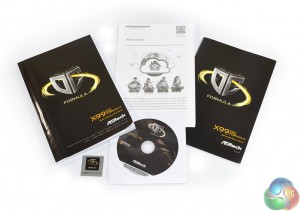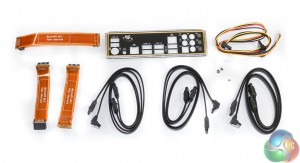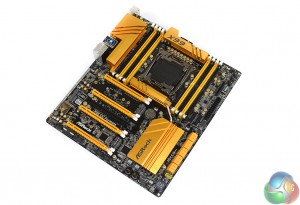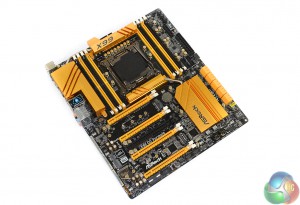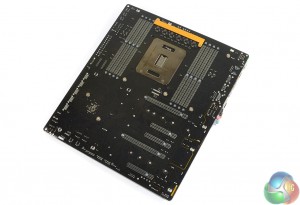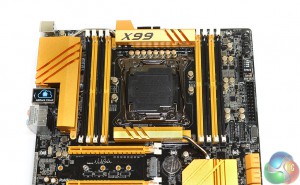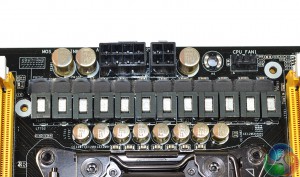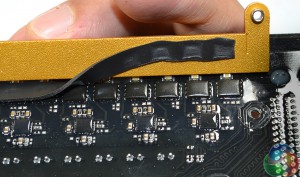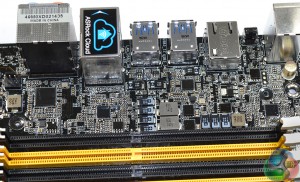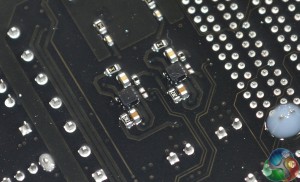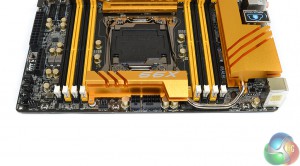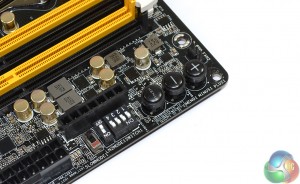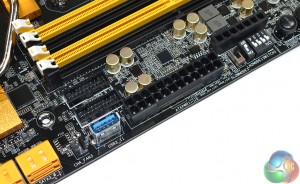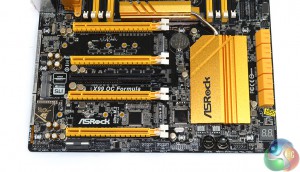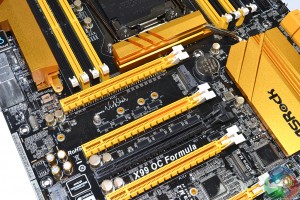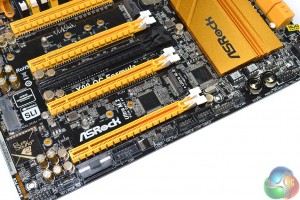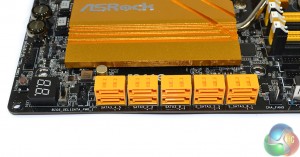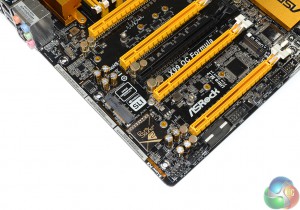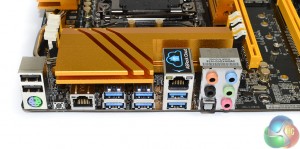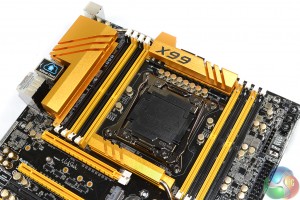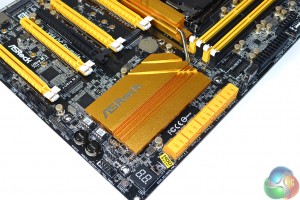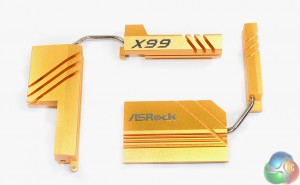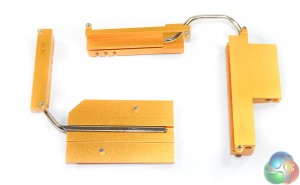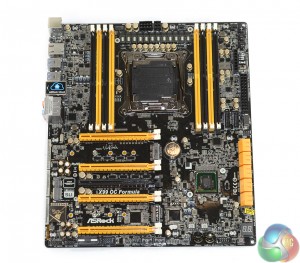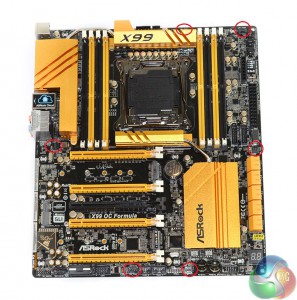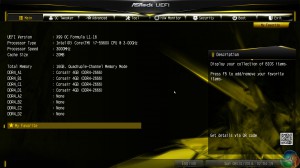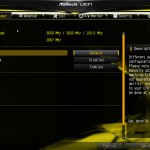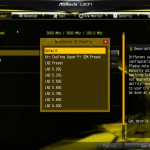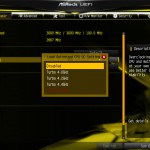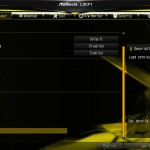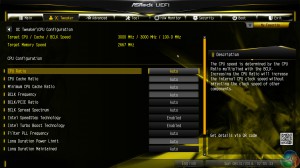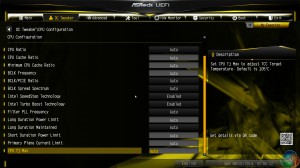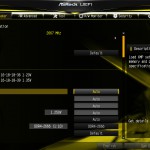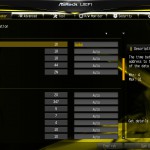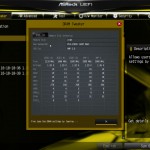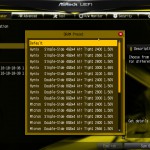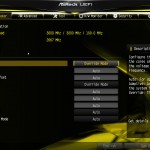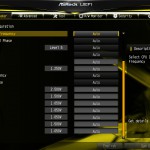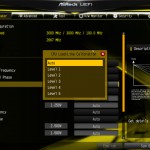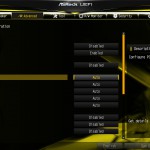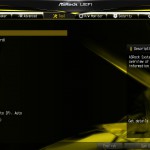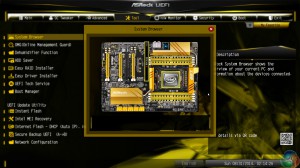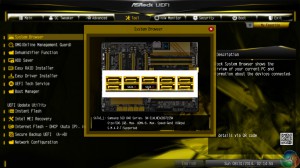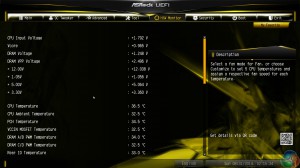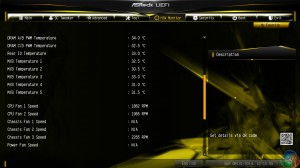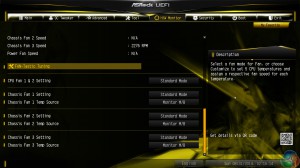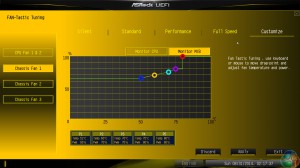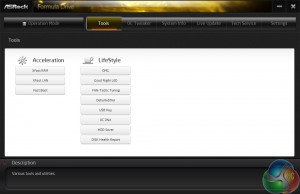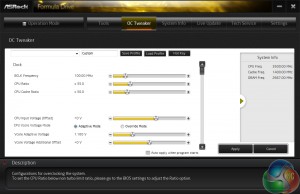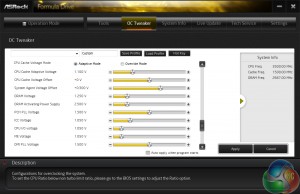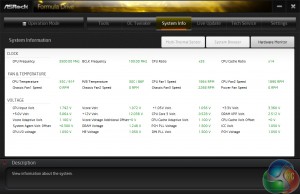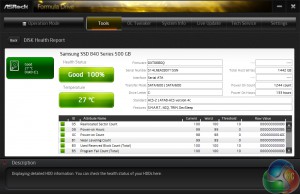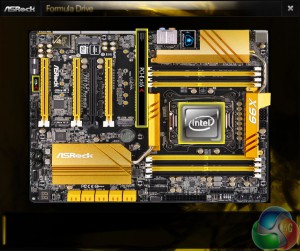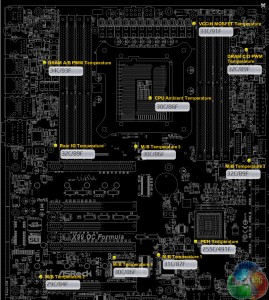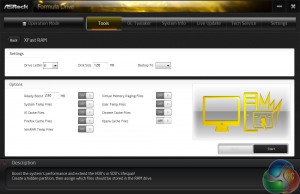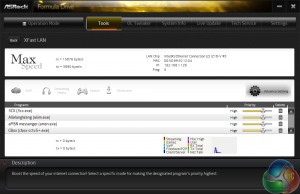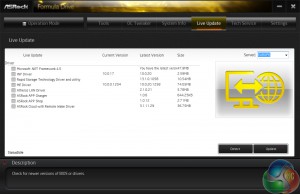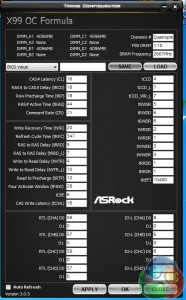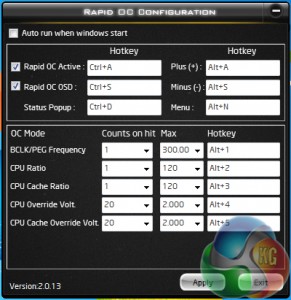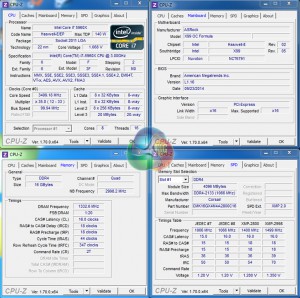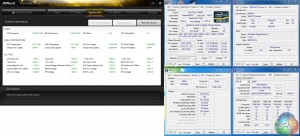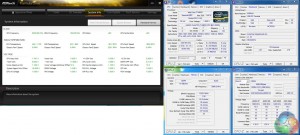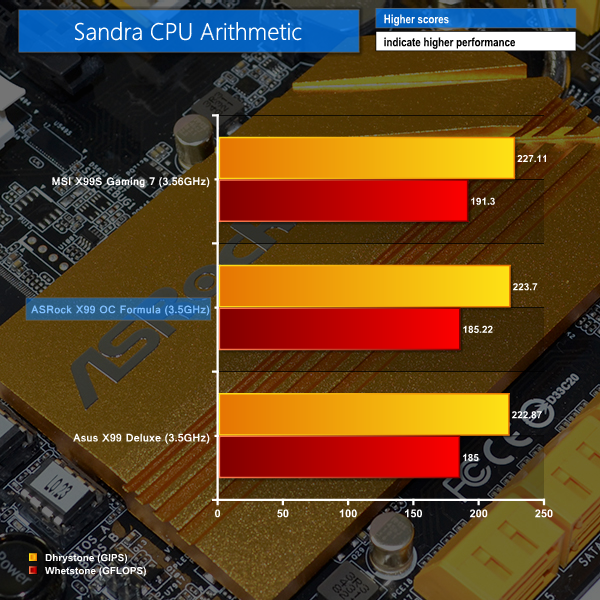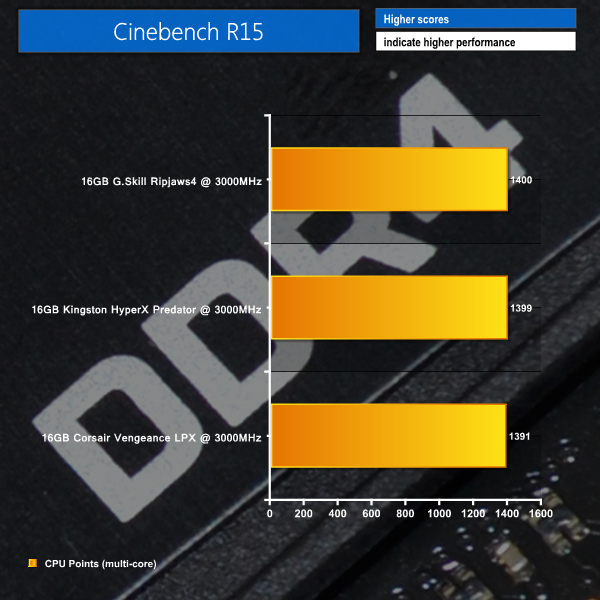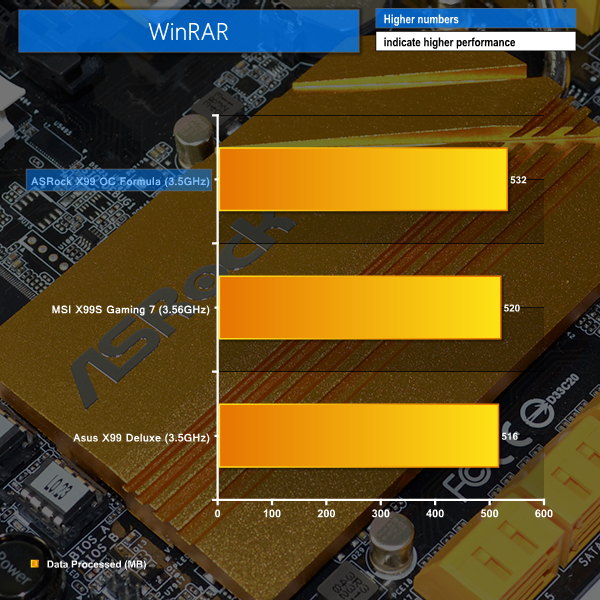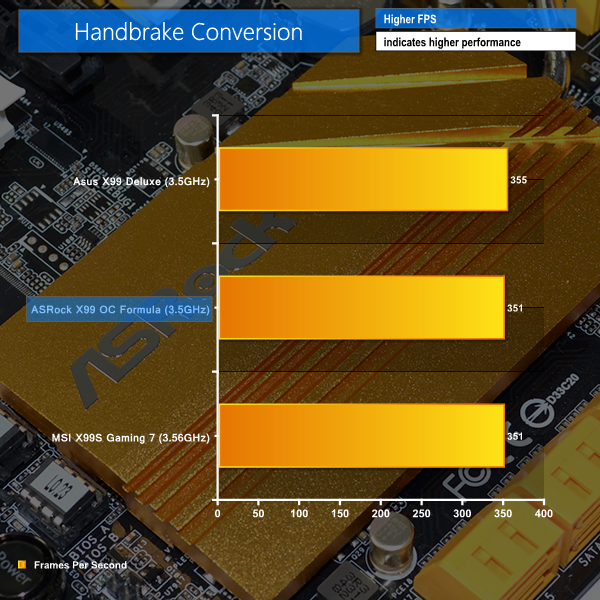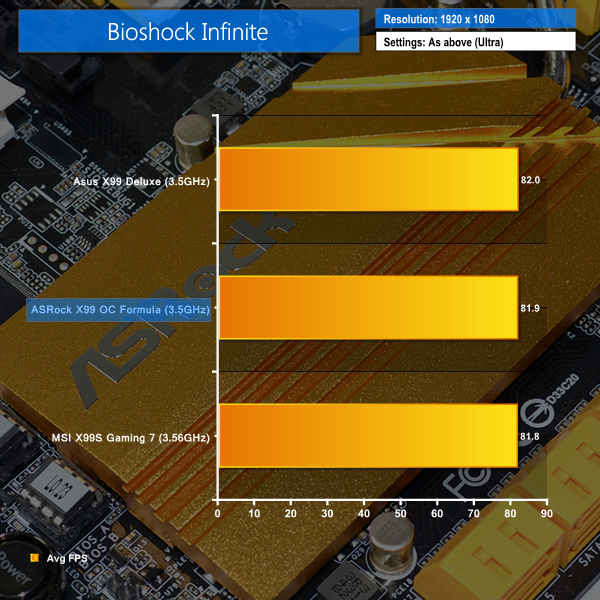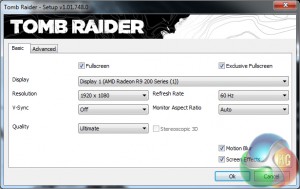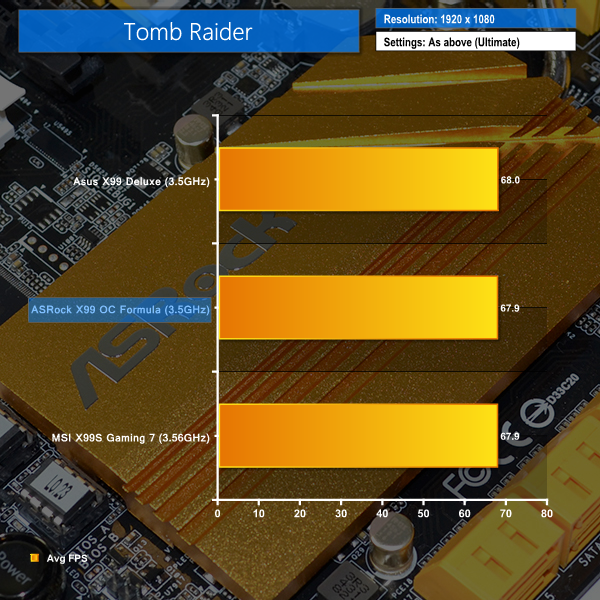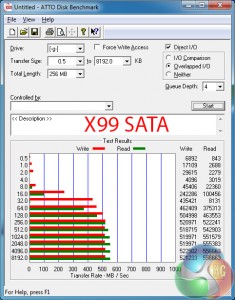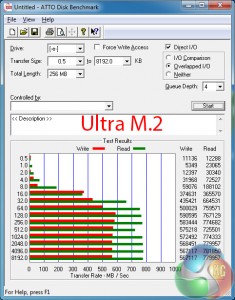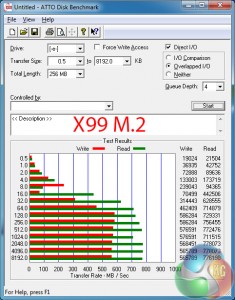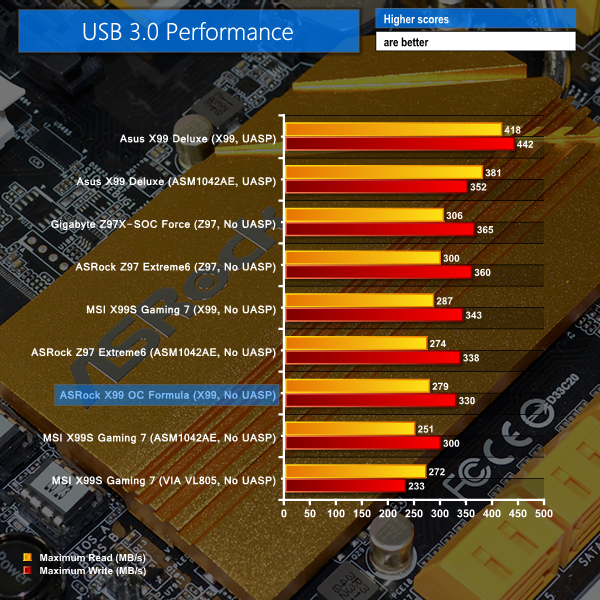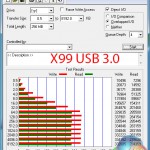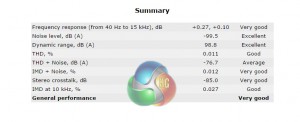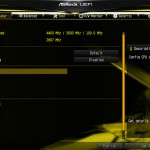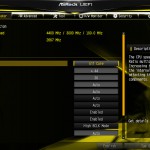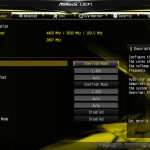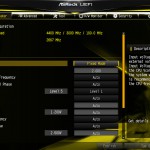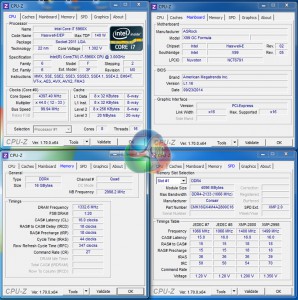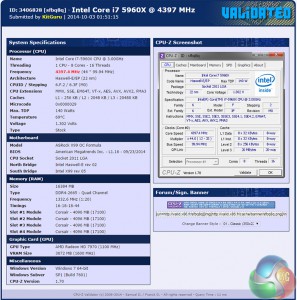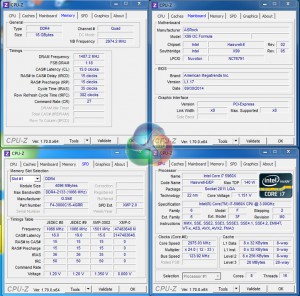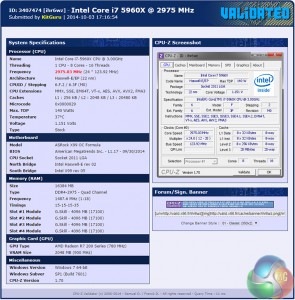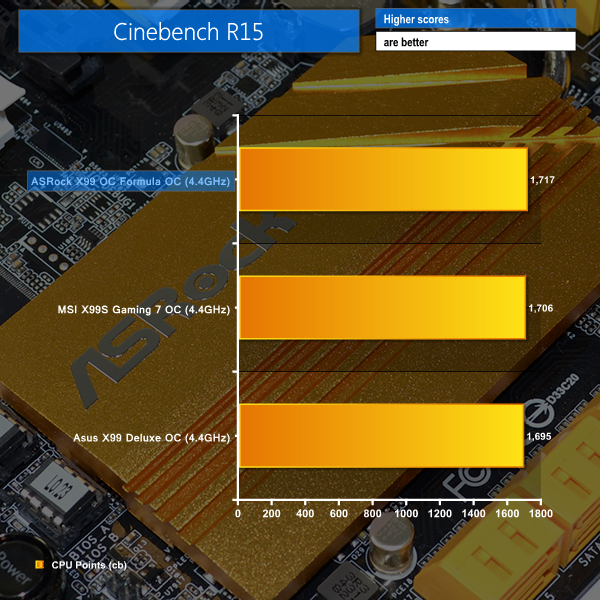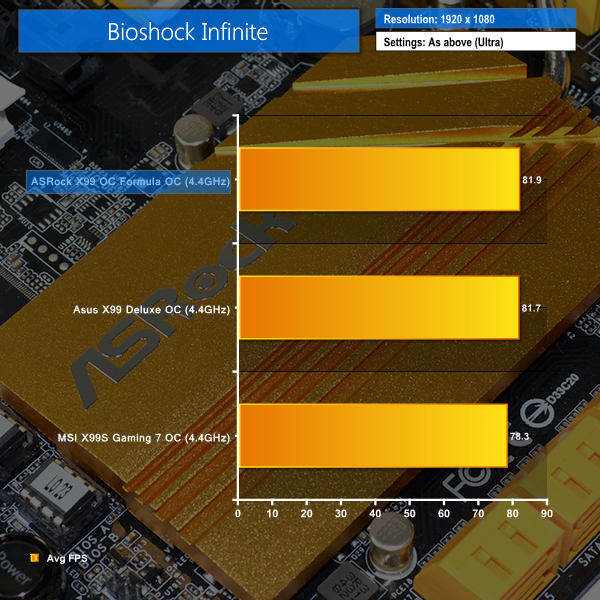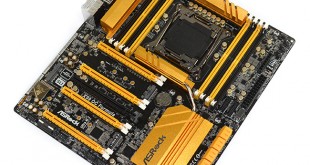
In case you missed our recent review of the Core i7 5960X, Intel's first consumer eight-core CPU is an all-round powerhouse with strong overclocking potential to boot. So what better way to analyse ASRock's X99 OC Formula motherboard than by pushing our 5960X as far as we can take it?
ASRock's Z87 OC Formula was one of the best LGA1150 motherboards that we ever tested, but can the LGA2011-3 X99 OC Formula live up to the success of its sibling?

With a twelve phase CPU power delivery system capable of delivering up to 1300W, it is clear that ASRock designs the X99 OC Formula from the ground up with extreme overclockers in mind. But that overclocking capability doesn't stop at the CPU; four power delivery phases are allocated to the eight DIMM slots which leads ASRock to suggest 3400MHz+ memory speeds as a possibility.
But perhaps as much relevance to buyers is that fact that one of the world's top professional overclockers – Nick Shih – had a large part to play in the board's design. From tweaking the UEFI settings and parameters to providing fine-tuned overclocking profiles – having a board that is built by overclockers, for overclockers, is important to many end-users.
Overclocking goes hand-in-hand with benchmarking, so it's no surprise to see ASRock deploying 4-way SLI and CrossFire support. There are also two fast storage links – a 20Gbps M.2 slot and ASRock's 32Gbps Ultra M.2 connector. And then there's the unique Conformal Coating that provides a moisture-protection layer atop the motherboard's PCB and electronic controllers.
Let's take a more in-depth look at the X99 OC Formula's hardware and see how it performs in our benchmark suite and overclocking tests.
Features:
- ASRock Super Alloy components.
- OC Formula Kit.
- OC Formula Connector Kit.
- Supports LGA2011-3 Core i7 and Xeon processors.
- Digi power, 12 power phase design.
- Supports up to 128GB of quad-channel 3400MHz+ DDR4.
- 10 SATA 6Gbps, 1 Ultra M.2, 1 M.2.
ASRock ships the X99 OC Formula in a grey and black box that is typical for the series. The front side features the X99 OC Formula product name in stylish writing, while the rear outlines the board's key features with greater depth.
Supplied documentation consists of the usual affair of manuals and guides. ASRock also supplies a drivers CD and OC Formula-branded case badge.
Cables and accessories supplied with the X99 OC Formula are situated inside a pull-string cloth bag. While this is not much use directly from the factory, it is helpful to users who open up a set of cables and then put them back in storage – no longer do they spill about the empty motherboard box.
Six SATA leads, three SLI ribbons, the HDD Saver cable, three screws for M.2 and mPCIe devices, and the rear IO shield form the X99 OC Formula's supplied bundle.
ASRock includes three flexible SLI ribbons which are capable of teaming together to support 4-way SLI configurations. This can be done by connecting the three bridges as follows; one to the first and second, another linking the second and fourth, and the last one joining the third and fourth graphics cards' SLI tabs.
While a dedicated 4-way SLI bridge is the cleaner approach, enthusiast overclockers are unlikely to care for the aesthetics of their graphics configurations' cables. That same point makes the ribbons' ugly beige colouring less of an issue.
Sticking to its striking appearance for overclocking-orientated motherboards, the ASRock X99 OC Formula uses an eye-catching black and yellow scheme. Under certain lighting conditions the yellow heatsinks and connection ports seem to have a gold tint about them – especially the reflective blocks of aluminium cooling material.
Having proven popular with its previous OC Formula motherboards, ASRock has again called upon its Conformal Coating feature for the board's PCB and many of the components. The protective coating prevents conductive liquids from causing damage to the board and its electronic components. That's particularly convenient for overclockers who may be using water-based coolant (which soon becomes conductive due to dust contamination).
Even those with more exotic cooling solutions, such as liquid nitrogen, are going to see Conformal Coating as a convenience that allows them to spend less time insulating their motherboard with such a high precision.
In order to fit the necessary components on its PCB, ASRock extends the X99 OC Formula to the E-ATX form factor. This is unlikely to be an issue for most overclocking-geared users as it has been a common move by motherboard vendors for many generations with their extreme-performance parts.
To emphasise the point that cooling is taken seriously on its X99 OC Formula, ASRock ensures that the rear MOSFETs are provided with their own strip of aluminium and a thermal pad.
Eight DDR4 memory slots are split equally either side of the sizable LGA2011-3 CPU socket. The single-latch memory slots are all moved closer to the board's top edge, allowing for the primary PCIe expansion space to be populated. Up to 64GB of DDR4 memory can be installed by means of populating the eight slots with 8GB modules, or you can use 128GB if you can source 16GB memory sticks.
Aiming to cater for all user bases, ASRock gives the X99 OC Formula support for ECC and non-ECC memory via Unbuffered or Registered DIMMs. An Intel Xeon E5 series processor is required to use ECC memory – consumer Haswell-E parts do not support the spec.
For mainstream users, the workstation-grade ECC and Registered DIMM (RDIMM) specs are unlikely to be of any interest – it's the standard (G.Skill Ripjaws4, Corsair Vengeance, etc.) non-ECC, Unbuffered DIMMs you'll want. To workstation or server users, however, ECC and/or RDIMM sticks can be useful in providing error-prevention with high-density, high-speed memory configurations.
ASRock claims support for memory speeds in excess of 3400MHz, although, when using consumer-level DDR4 kits, that ability will be heavily influenced by the strength of a Haswell-E chip's Integrated Memory Controller (IMC) and the board's BIOS maturity.
Space around the X99 OC Formula's CPU socket gets tight when you start thinking about sub-zero cooling. It's the aluminium heatsink, in the area where the Northbridge was once sat many generations ago (just below the CPU socket), that is likely to cause the most interference with large LN2 pots. Cooling companies design for tall VRM heatsinks above the CPU socket, but those found in the Northbridge area are less common.
A twelve phase power delivery system feeds the LGA2011-3 CPU. ASRock suggests that the system can deliver up to 1300W of power, translating into an impressive 108W per physical electronic phase.
Looking more specifically at the components, ASRock opts for a 6-phase Intersil ISL6379 PWM controller to provide the overall VRM management. Six Intersil ISL6611A phase-doublers each take a single PWM input lane from the ISL6379 and convert it to two PWM output lanes. This allows ASRock to control up to twelve power delivery phases for the CPU.
Finding information for the ISL6379 PWM chip is very difficult, although numerous sources suggest that it is a ‘hybrid' analog/digital controller. If that is indeed the case, it's the analog section of the controller that is to thank for ASRock's rapid voltage switching frequency which leads to positive power consumption numbers under static loads (as we will outline later). However, some of the enhanced accuracy and future-looking voltage level projection may be missing compared to a purely digital component.
Twelve unmarked chokes, each of which ASRock rates for a 60A output, are joined by 24 Fairchild FDMS3660S dual N-channel MOSFETs. The front dozen MOSFETs are electronically linked in parallel with the rear dozen, allowing the twelve available PWM channels to provide overall control for every transistor. The X99 OC Formula features roughly $22 worth of MOSFETs just for the CPU (although the OEM probably pays less by bulk ordering).
I'm actually quite surprised to see ASRock opting for the Fairchild MOSEFTs when some of its previous OC Formula parts used Texas Instruments' NexFET solutions, which are widely believed to compete with International Rectifiers' IR355x PowIRStage alternatives for the MOSFET crown. The move would imply that ASRock has strong confidence in the Fairchild components, but performance numbers from extreme overclockers will provide the best comparison data.
ASRock also uses Nichicon ‘Platinum' capacitors, rated for 12,000 operating hours at 105°C, for power delivery functions. Scale that running temperature down to a realistic operating value and it translates into a very long operational lifespan for each capacitor.
Two more ISL6379 PWM controllers manage the X99 OC Formula's 4-phase memory power delivery system. ASRock uses ‘Premium Memory Alloy Chokes‘ which are suggested to deliver their current with reduced temperatures.
The Conformal Coating makes it difficult to read what is written on the electronic components, although I did notice Sinopower SM4337 MOSFETs in the memory's vicinity. There is also a pair of Richtek RT9045 regulators which (presumably) work with DDR voltage applications.
ASRock equips the X99 OC Formula with two CPU power connectors – one of the 4-pin variety in addition to the common 8-pin version. This is a smart move by ASRock because that additional 4-pin connector is useful when extreme overclockers are pushing heavy voltage levels.
Two CPU fan headers are positioned along the top edge, both of which are controlled through the same CPU fan channel.
The plus and minus buttons in the board's top-right corner control adjustments to the BCLK. ASRock includes the staple overclocker and benchmark features – slow and LN2 mode toggles, PCIe slot disable switches, and voltage reading points called V-Probe.
A standard USB 3.0 port is joined by two outwards-facing internal USB 3.0 headers, adjacent to the 24-pin connector. A 4-port ASMedia ASM1074 hub is used to provide two headers worth of USB 3.0 outputs from a single input.
4-way SLI and CrossFire are both supported by the X99 OC Formula, provided a 40-lane CPU is used. The yellow slots are to be used for graphics cards, the first and third of which are hard-wired for up to sixteen PCIe lanes, with the other two linking by a maximum of eight lanes. ASRock recommends installing any necessary expansion devices in the black connector (which shares its bandwidth with the PCIe 3.0 x4 Ultra M.2 slot).
The uppermost (PCIE1) PCIe slot is used for a full x16 link to one card, while two cards are given sixteen lanes each, as well as a cooling gap, using the PCIE1 and PCIE4 connectors. Three cards rely upon the first three yellow connectors, and are linked to the CPU at PCIe 3.0 x8/x8/x16. 4-way configurations use all of the yellow PCIe connectors in an x8/x8/x8/x8 link.
I have no problems with ASRock's PCIe configuration; the layout is smart and 4-way SLI/CrossFire can be used alongside a PCIe 3.0 x4 SSD in the Ultra M.2 slot.
Situated next to the SLI and CrossFire badges is a mini-PCIe connector. The 5Gbps PCIe 2.0 port can be used to house a WiFi card, without competing against graphics cards for the precious expansion slots.
Standard connections, such as front panel and USB 2.0 headers, are found along the motherboard's bottom edge. ASRock also includes COM and TPM connectors, as well as a ThunderBolt header, presumably to tie in with the PCIe clock speed.
Additional connectors come in the form of onboard power, reset, and Direct Key buttons. ASRock positions these buttons away from the DRAM area where they could freeze due to sub-zero cooling vapors, but a graphics card installed in the lowest slot will block their access. Positioning of onboard overclocking buttons can be a task that is highly likely to cause interference issues for at least one set of users.
A BIOS selection switch allows users to load the backup system in the case of a crash. ASRock's Dr. Debug LED displays error codes.
A downwards-facing 4-pin molex connector is used to provide additional power to multi-VGA configurations. Its position and orientation are both smart – a cable can be routed behind the motherboard tray and hidden with ease in a chassis environment.
Sat beneath the primary PCIe slot, ASRock links its ‘standard' M.2 connector with four chipset-fed PCIe 2.0 lanes. This gives a bandwidth capability of 20Gbps, which is twice as fast as the typical 10Gbps M.2 solution found on most Z97 boards (or as a backup measure for some X99 parts). A SATA 6Gbps lane can also be fed to the connector for use with M.2 SATA devices, although we aren't sure why you'd want to use such a drive (one less component to lose, perhaps).
ASRock's Ultra M.2 slot sits above the motherboard's lowest PCIe connector. Four CPU-fed PCIe 3.0 lanes are fed to the connector, giving it a bandwidth capacity of 32Gbps. As we have already pointed out, the Ultra M.2 connector can be used at all times with a 40-lane CPU, irrelevant of how many graphics cards are connected.
We tested ASRock's Ultra M.2 connector, with Samsung's ultra-fast XP941 SSD, in our review of the Z97 Extreme6 and were thoroughly impressed by its throughput capability.
Drives up to 110mm-long can be installed in both of the M.2 connectors. Unfortunately the M.2 connectors do not support any RAID function with each other. ASRock tells us that this is because their connections are provided from different sources (the CPU and the X99 chipset).
A future improvement could come via support for RAID with M.2 SSDs. ASRock's PCIe slot configuration leaves eight PCIe 3.0 lanes from the CPU spare when four graphics cards are used. Using an additional switch to split this eight-lane link down to a pair of four-lane links would be enough to drive two Ultra M.2 connectors. And with the PCIe 3.0 lanes originating from the same source (a 40-lane CPU), there is the potential for RAID functions to be supported.
Ten SATA 6Gbps ports, all of which are delivered by the X99 chipset, are found on the X99 OC Formula. Only the six ports to the left (SATA3_0 to SATA3_5) support RAID 0, 1, 5, and 10. The four remaining ports do not support any form of RAID, and S_SATA3_3 shares its link with the M.2 connector.
ASRock's HDD Saver feature is supported by the X99 OC Formula, the header for which is found left of the SATA ports (in the above photograph). HDD Saver can control up to two SATA drives (with the supplied cable) by switching them off via software as required for privacy, durability, or power saving purposes.
Five months ago I would have criticised ASRock for the decision to leave out SATA Express. Wind the clock forward almost half a year and it is clear that M.2 is the (far) more popular interface (and probably will be for the near future), so the lack of SATA Express functionality doesn't seem like a huge issue.
Realtek’s ALC1150 codec, with its 115dB signal-to-noise ratio (SNR), provides the foundation for ASRock's Purity Sound 2 audio system. EMI shielding and a distinct PCB pathway is used to minimise signal interference.
A pair of Texas Instruments NE5532 operational-amplifiers are used to provide support for 600 Ohm headsets, while Nichicon fine gold series capacitors (largely 100µF and 10V specification) filter the audio signals.
You may be quick to question the relevance of an enhanced audio solution on an overclocking-geared motherboard. The fact of the matter is that many hobbyist overclockers will purchase one motherboard for their usage. That board has to carry out their day-to-day computing tasks, which could include gaming or audio playback, and then be stripped down and stuck on the bench for overclocking sessions, when they occur.
With that point in mind, motherboard vendors are challenged with creating a board that caters for all users and also has enhanced overclocking potential to boot. And that's why we see many ‘general-usage' and gaming features popping up on overclocking-orientated motherboards.
Six USB 3.0 ports are found on the rear IO panel, four of which are provided by the board's second ASMedia ASM1074 hub controller. A pair of USB 2.0 ports and one PS/2 connection are provided for overclockers or gamers who prefer the connections for their peripherals.
Two Gigabit Ethernet ports are utilised – one of which is provided by Intel's I218-V chipset, with the other originating from an onboard Qualcomm Atheros AR8171 PCIe-based chipset. The Qualcomm NIC is used to provide support for the ASRock Cloud network-based services.
Completing the rear IO ports are audio connections and the always-convenient clear CMOS button.
Called ‘XXL Aluminium Alloy‘ heatsinks by ASRock, two metal blocks are connected via a flattened heatpipe and tasked with cooling the intense MOSFET system. The chipset and ‘Northbridge' heatsinks are also connected via a heatpipe to ensure a satisfactory level of cooling for the X99 PCH.
Since ASRock switched to its larger VRM heatsinks, the small cooling fan that was fitted to Z77 and Z87 versions of the OC Formula has been removed. Also gone are the pre-fitted watercooling barbs. Those are both positive points; feedback suggested that watercoolers prefer to choose their own fittings (and VRM waterblocks, for that matter), while overclockers are likely to use a dedicated fan for cooling the MOSFETs during heavy, benchmark-induced loads.
Avid memory overclockers will notice the potential for interference between large LN2 memory cooling pots and the left VRM heatsink. The motherboard heatsink should be short enough to fit beneath LN2 memory cooling pots which tend to extend at a higher position.
Removing the two sets of heatsinks is a task that is left intentionally simple by ASRock. A number of easy-to-access screws hold each heatsink in place and they are manufactured and fitted to come off easily. This is a positive point for those looking to upgrade their VRM cooling capacity, or overclockers who regularly switch between the stock and an after-market heatsink, depending on their usage scenario.
The particularly minuscule level of contact between the chipset and its heatsink implies that the metal is more for appearance than performance. I do not see the need for the ‘Northbridge' heatsink, either; its positioning causes the potential for interference and it doesn't cool anything of particular worth (or heat output).
We wouldn't be surprised to see manufacturers such as EK providing VRM or full-cover waterblocks for the X99 OC Formula. An individual VRM heatsink that covers both MOSFET areas seems the most likely solution; making a full-cover block span from the MOSFET area down to the chipset doesn't seem to be possible with the path restrictions.
Six fan headers are provided on the X99 OC Formula, four of which are 3-pin. Distribution of the fan headers is smart – four are accessible from the CPU socket, and two are placed along the board's bottom edge.
ASRock employs two Nuvoton SuperIO chipsets – the NCT6791D and NCT6683D-T. While they can both perform the same voltage, temperature, and fan speed monitoring functions, I'd wager that the more advanced NCT6683D-T is included for its enhanced fan control and SPI flash capabilities.
Firstly, we are pleased to report that our NZXT Avatar S mouse worked to its usual standard in the ASRock X99 UEFI BIOS. We’ve found our NZXT Avatar S to be the most troubling mouse with UEFI support, so when it functions correctly in the interface, that is usually a good sign for overall mouse support.
ASRock's X99 UEFI is very similar to its Z97 implementation. The interface uses a 1920×1080 display resolution.
The Main page displays information about the system components. There is a My Favorite section that gives users quick access to their most desirable settings.
The OC Tweaker page controls access to the board's numerous overclocking-related sub-sections. I like the way that ASRock has split its main overclocking sections into separate folders. This keeps the interface clean and makes the desirable settings easy to find. It also proves that ASRock is listening to feedback and taking steps to improve its UEFI user experience.
Overclocking profiles designed by one of the world-leading professional overclockers – Nick Shih – can be loaded from the UEFI. There are also some less extreme overclocking profiles set by ASRock's engineers.
Up to five customised user profiles can be saved to the board's internal memory. Given that the X99 OC Formula is designed for overclockers and tweakers who regularly adjust their settings, I would have preferred more profile save points to be provided. That said, a USB flash drive can be used to transfer profiles to and from the board.
The standard set of parameter and ratio settings are provided under the CPU Configuration section. ASRock also adds a CPU TJ Max input which is a unique setting allows users to change their processor's thermal throttling temperature.
There is a strong range of memory overclocking settings provided in their specific sub-section. Users can adjust their DRAM frequency and voltage in addition to viewing their kit's rated, and applied, timings.
A large number of pre-tweaked (presumably by Nick Shih) overclocking profiles are included in the memory section. I would advise caution before loading any of the profiles as a test to see what your memory is capable of – anything more than 1.50V is particularly high for DDR4 and should be approached with caution.
Settings relating to the Haswell-E processor's Fully Integrated Voltage Regulator (FIVR) are given their own section. Here users can apply the primary voltage settings that will deliver their quick-and-easy overclocked settings.
Moving over to the Voltage Configuration section is where the settings get more advanced. Experienced, and knowledgeable, overclockers can use the parameters in this section to fine-tune their system so that every last MHz is squeezed out of it.
ASRock typically allows users to opt for automatic, manual, or adaptive voltage configurations.
The Chipset Configuration section is useful when ensuring that each graphics card is receiving the correct PCIe bandwidth in a multi-VGA configuration.
ASRock includes a number of convenient tools in its UEFI. Users can rapidly apply a number of system configurations and drivers can also be downloaded via the interface.
Instant Flash, ASRock's simple BIOS updating tool, scans through one's USB flash drive to search for the relevant BIOS file. While this sounds good, with the tool's ability to scan all the way through your memory drive until it finds the relevant BIOS profile, users with a large amount of data on their drive could find the search time to be in the order of minutes. There's nothing wrong with a manual folder search.
System Browser is a convenient tool that displays which components are connected to the motherboard. The tool is particularly useful for troubleshooting purposes; if, for example, a memory stick is faulty, it will not show up in the System Browser window.
ASRock includes an extensive set of voltage, temperature, and fan speed readings on its HWMonitor page. This is where the pair of Nuvoton SuperIO chipsets and numerous board-placed thermal reading points prove valuable.
There are two ways of setting fan speeds in ASRock's UEFI. Users can either select from pre-defined profiles, or they can fine-tune their own custom fan speeds. There's the old way of doing this – by selecting the relevant choices from multiple drop-down lists. Or there's ASRock's modern FAN-Tastic Tuning visual tool.
I was very impressed by the capabilities of the FAN-Tastic Tuning tool (the cheesy name, on the other hand…). The five-point curve can be adjusted to an individual's preference with a large range of freedom; a CPU temperature as low as 30°C can be set, while the fan can run at 0% or 20-100% in 1% increments. And what is particularly impressive is the board's ability to completely shut-off a controlled fan below a user-defined temperature threshold.
I hope ASRock's other X99 and future motherboards use a similar iteration of the FAN-Tastic Tuning tool. The level of control it provides is excellent, especially when a fan can be set to stop spinning in order to provide a particularly quiet system.
UEFI Summary
In the latest motherboard platform launches, ASRock has worked hard to improve its UEFI. The company has moved to a Full HD – 1920×1080 – resolution, the layout has been re-ordered, the styling has changed, and new-and-improved tools have been designed.
ASRock now has a UEFI that I would deem to be right on the heels of Asus' solution, making it the second best interface on the market (in my opinion). And there are some clear areas where ASRock's interface trumps that of Asus' (System Browser, for example). What is equally positive is that ASRock has clearly listened to user feedback that said the UEFI needed to improve its layout and that the fan control methods could be improved.
The only (minor) criticism I have with the X99 OC Formula's UEFI is that five settings save points may not be enough for the board's tweaker-based target audience. Other than that, the interface is well laid-out, easy to use, and full of relevant user-customisable parameters.
ASRock Formula Drive
ASRock includes a number of tools in its Formula Drive software suite.
Overclocking settings and parameters can be tweaked via the software, in an OS environment.
Readings relating to system parameters such as voltages, frequencies, and fan speeds are outlined in the System Info page, although not all of them are correct (as we will discuss later in the review).
The health and other general statistics relating to a storage drive can be read via one of ASRock's tools.
ASRock also puts its convenient Board Explorer tool in the Formula Drive software package. There's also a section that displays the temperature being read by each of the board's eleven monitoring points.
XFast RAM can be used to create RAM drive, while XFast LAN gives users the opportunity to control their network bandwidth allocation (much like Killer's Network Manager software).
Live Update is well-implemented by ASRock and is more convenient than trawling through a website full of drivers.
ASRock Software
There are light tools that outline some of the X99 OC Formula's operating parameters.
App Shop can be used to download new software, including some pieces from external companies, such as Google.
ASRock also includes 1-year subscription to Orbweb.ME (worth $50) which will be welcomed by users who opt for cloud storage.
We will be outlining the ASRock X99 OC Formula motherboard's performance with the Core i7 5960X CPU at its stock frequency (3.5GHz due to forced turbo). Overclocked performance will be outlined later in the review.
By default, the ASRock X99 OC Formula motherboard does not apply multi-core turbo (MCT) when XMP is enabled. Manually applying MCT with XMP enabled, and Corsair's 127.3MHz BCLK used, lead us to a few unstable boots (possibly VCore-related). Given the choice between an all-core 3.5GHz frequency or an extra 133.3MHz of memory speed, we enabled MCT and manually set the memory frequency to 2666MHz. This will be displayed as the ‘stock’ setting.
The biggest reason for this incompatibility is the awkward 127.3MHz BCLK used by Corsair's 2800MHz modules. Memory issues are plaguing the entire X99 line-up, with the exception of Asus' boards which seem solid in our testing.
(Idle left, load right).
ASRock's implementation of the Nuvoton NCT6791D and NCT6683D-T chipsets report a real-time CPU core voltage but not in the ‘CPU VCore' section of software, annoyingly. The X99 OC Formula doesn't fix that issue; CPU-Z, HWMonitor, and ASRock's own Formula Drive monitoring software all delivered incorrect readings for our chip's VCore level. The latter does, however, feature a ‘CPU Core 3 Volt.' reading that accurately displays the voltage of an eight-core chip's third core, which can be assumed as the voltage for all cores.
While this is annoying, it is not a major concern as overclockers are more likely to rely on the board's built-in voltage reading points and a multimeter, as we did. We recorded idle voltages bouncing around the 0.2V-mark, but dropping as low as tens of millivolts, while load voltage sat around a level of 1.08V. ASRock's PWM controllers always prove successful in rapidly dropping voltages when the system is idling.
X99 Motherboard Test System:
- Processor: Intel Core i7 5960X ES (3.5GHz forced turbo).
- Memory: 16GB (4x 4GB) Corsair Vengeance LPX 2800MHz CL16 DDR4 @ 2666MHz 1.20V.
- Graphics Card: Asus R9 280X Matrix Platinum 3GB.
- System Drive: 500GB Samsung 840.
- CPU Cooler: Corsair H100i.
- Case: NZXT Phantom 630.
- Power Supply: Seasonic Platinum 1000W.
- Operating System: Windows 7 Professional with SP1 64-bit.
Compared X99 Motherboards:
- Asus X99 Deluxe (BIOS 0801) – with 16GB (4x4GB) G.Skill Ripjaws4 3000MHz 15-15-15-35 DDR4 @ 1.35V.
- MSI X99S Gaming 7 (BIOS V17.3B1) – with 3.56GHz CPU and 16GB (4x 4GB) Corsair Vengeance LPX 2800MHz CL16 DDR4 @ 2800MHz 1.20V.
With memory issues still plaguing many boards on the X99 chipset, we are still struggling for test system consistency from one review to another. MSI's board was happy to use 2800MHz memory and the higher MCT frequency its increased BCLK brought about. Asus' X99 Deluxe played along with 3GHz memory and the 3.5GHz MCT CPU frequency that the 125MHz base clock ties in with. Challenging, isn't it?
Software:
- ASRock X99 OC Formula BIOS v1.16 (latest at start of testing).
- Catalyst 14.4 VGA drivers.
Tests:
- 3DMark 1.3.708 – Fire Strike (System)
- SiSoft Sandra 2014 SP2 – Processor arithmetic, memory bandwidth (System)
- Cinebench R15 – All-core CPU benchmark (CPU)
- WinRAR 5.10 – Built-in benchmark (CPU)
- HandBrake 0.9.9 – Convert 4.36GB 720P MKV to MP4 (CPU)
- ATTO – SATA 6Gbps, USB 3.0, M.2 transfer rates (Motherboard)
- RightMark Audio Analyzer – General audio performance test (Motherboard)
- Bioshock Infinite – 1920 x 1080, ultra quality (Gaming)
- Metro: Last Light – 1920 x 1080, high quality (Gaming)
- Tomb Raider – 1920 x 1080, ultimate quality (Gaming)
3DMark
We used 3DMark‘s ‘Fire Strike’ benchmark which is designed to be used on gaming PCs. We opted for the Normal setting, NOT the Extreme mode.
Sandra Processor Arithmetic
Sandra Memory Bandwidth

The physics score in the 3DMark Fire Strike benchmark takes a noticeable hit from the X99 OC Formula's lower memory speed, compared to the Asus and MSI boards. The same can be said for memory bandwidth numbers, as reported by the Sandra benchmark.
Sandra's CPU Arithmetic test runs independently of intensive memory input and shows similar scores between the Asus and ASRock boards, both of which used the 5960X at 3.5GHz. MSI's slightly better score is attributed to its higher CPU speed due to an XMP-adjusted base clock.
Cinebench
We used the ‘CPU’ test built into Cinebench R15 .
WinRAR
WinRAR’s built in benchmark and hardware test can help us outline the performance differentials between each motherboard. We record the amount of data processed after a 30-second run.
Handbrake Conversion
We measured the average frame rate achieved for a task of converting a 4.36GB 720P MKV movie to 720P MP4 format.
Regular Haswell showed tendencies towards 2666MHz in terms of real-world performance. 2666MHz always seemed the general sweet spot for DDR3 memory on an LGA 1150 system – any higher would start reducing performance due to loosened tertiary timings, whereas slower typically couldn't keep up purely due to frequency differences.
That same tendency is being shown by our Haswell-E system based around ASRock's X99 OC Formula. With its 2666MHz DDR4 and 3.5GHz CPU, the ASRock X99 OC Formula is able to outperform both the Asus and MSI boards in WinRAR, while it manages second place in Cinebench and Handbrake (joint with MSI's X99S Gaming 7).
Bioshock Infinite
We used the Bioshock Infinite demanding ‘Ultra’ setting and a 1920×1080 resolution to push today’s gaming hardware. Our data was recorded using a section of the game, not the built-in benchmark.
Metro: Last Light
We used a 1920×1080 resolution and the Metro: Last Light built-in benchmark set to ‘High’ quality to offer an intense challenge for the gaming hardware while also making playable frame rates a possibility.
Tomb Raider
We used a 1920×1080 resolution and the Tomb Raider built-in benchmark set to ‘Ultimate’ quality.
Gaming performance is very similar between each of the motherboards, irrelevant of the CPU and memory frequencies. ASRock's X99 OC Formula is one-tenth of a frame off top spot in the Tomb Raider and Bioshock Infinite tests. The board does, however, drop by a third of a frame in the Metro: Last Light benchmark.
SATA
For SATA 6Gb/s testing we use a Kingston HyperX 3K (SandForce SF-2281) SSD.
SATA 6Gbps performance is as we would expect from a modern SSD. The X99-fed ports on ASRock's X99 OC Formula are unlikely to hamper the performance of a modern SATA 6Gbps SSD.
M.2 connector
We use Plextor‘s fast M6e 256GB M.2 SSD to test the speed of a motherboard's M.2 connector. We reviewed the 512GB Plextor M6e (and its PCIe x2 adapter card) HERE. Unfortunately we do not have access to a PCIe 3.0-based SSD to fully test the M.2 connector's performance limits.
Both the 32Gbps Ultra M.2 connector and the chipset-fed 20Gbps M.2 slot are capable of pushing Plextor's popular M6e SSD to its limit. The high bandwidth capability of each connector is a clear form of future-proofing (if there is such thing in the world of computing).
USB 3.0
We tested USB 3.0 performance using the Kingston HyperX 3K SSD connected to a SATA 6Gb/s to USB 3.0 adapter powered by an ASMedia ASM1053 controller.
While it is clear that our Kingston SSD is suffering from age-induced slow downs, ASRock's X99 OC Formula still manages to show slight speed deficits in regards to USB 3.0 throughput.
The most fitting explanation that we can think of is that the two ASMedia ASM1074 hubs are introducing losses into the system for the eight USB 3.0 ports provided by them. Those losses are very small when compared with other non-UASP motherboards based on the X99 chipset.
Audio
We use RightMark Audio Analyzer (RMAA) to analyse the performance of the motherboard’s onboard audio solution. A sampling mode of 24-bit, 192 kHz was tested.
Realtek’s ALC1150 codec, with its 115dB signal-to-noise ratio (SNR), provides the foundation for ASRock's Purity Sound 2 audio system. EMI shielding and a distinct PCB pathway is used to minimise signal interference. A pair of Texas Instruments NE5532 operational-amplifiers are used to provide support for 600 Ohm headsets, while Nichicon fine gold series capacitors (largely 100µF and 10V specification) filter the audio signals.
According to RMAA, the Purity Sound 2 system used on ASRock's X99 OC Formula delivers ‘Very Good‘ general audio performance. The dynamic range and noise level results are particularly impressive, although the board struggles with distortion (in comparison to other performance aspects).
We are going to skip past our automated overclocking section because we would be highly surprised if anybody will make use of it on a board such as the X99 OC Formula.
Manual CPU Overclocking:
To test the ASRock X99 OC Formula motherboard’s CPU overclocking potential, we first increased the CPU VCore to 1.30V, Cache voltage to 1.25V, and CPU Input Voltage to 2.00V. We also disabled the FIVR power control setting, selected the High BCLK PLL mode, and applied level 1 LLC.
We maintained the DRAM frequency at 2666MHz to take its stability out of the overclocking equation. Cache frequency was maintained at 3.0GHz.
Overclocking in ASRock's logically laid out UEFI is straightforward. We simply adjusted our desired settings and rebooted the system.
We did, however, notice that the System Agent voltage can only be adjusted in an offset fashion. We would prefer full control over the parameter as it can help remove limitations for high memory speeds.
ASRock's X99 OC Formula was able to take our 5960X to its 4.4GHz limit with our applied overclocking settings. This is the same frequency that the MSI X99S Gaming 7 and Asus X99 Deluxe motherboards topped-out at.
When pushing to 4.5GHz with our voltage and power settings, the other boards that we have tested BSOD as soon as Prime95 load is applied. The X99 OC Formula was able to consistently run Prime95 load for approximately 15 minutes at 4.5GHz before finally giving in to a voltage-related BSOD. This speaks for the board's overclocking potential with further fine-tuned tweaking.
Under load conditions, ASRock's power delivery system proved its accuracy by delivering less than 10mV more than our desired 1.30V level. Heavy load saw the CPU VCore jumping as high as 1.308V through our multimeter reading, however ASRock's Formula Drive software was incorrectly displayed 1.32V for the Core 3 voltage.
In all honesty, we expected to see ASRock's X99 OC Formula hit our chip's 4.4GHz limit with ease. The overclocking-geared board is more likely to show performance benefits when pushing higher voltage levels with cooling solutions far superior to our Corsair H100i. Unfortunately we don't have access to LN2 cooling.
Memory Frequency Performance:
Using the L1.16 beta BIOS that we started testing with, our G.Skill Ripjaws4 and Corsair Vengeance LPX memory kits would not boot at their 3GHz XMP settings. The Corsair memory kit also faltered at its 2800MHz XMP profile, which is disappointing. It seems that the X99 OC Formula is badly tuned for the memory kits' XMP setting.
ASRock sent us a later BIOS revision (once we had completed the bulk of our benchmarking) which was suggested to improve memory frequency support.
While the 3000MHz XMP configuration on our G.Skill memory kit was still unable to be loaded, manually dropping the base clock 1MHz below the XMP setting resulted in stability at 2976MHz. ASRock's Formula Drive monitoring software suggests that 1.36V is being delivered to the memory, but we observed the correct 1.35V when read with a multimeter.
In addition to Asus' X99 Deluxe, the X99 OC Formula is the only motherboard that has been able to run our G.Skill memory kit anywhere near its 3GHz rated frequency. That said, Asus' board had no problem working with a 3100MHz memory speed (using a Kingston HyperX Predator DDR4 kit), whereas the X99 OC Formula couldn't push past 2976MHz.
Irrelevant of how simple the base clock adjustment process is, XMP should work without any user input. We hope that further BIOS updates will improve compatibility with high speed memory kits and the XMP configurations (that statement is valid for all of the motherboard vendors).
We will outline the performance increases that can be obtained from using the ASRock X99 OC Formula motherboard to overclock our system. Our overclocked processor frequency was 4.4GHz and memory speed was 2666MHz.
As a performance comparison, we have included the overclocked results from two other X99 motherboards. The maximum overclocked configuration achieved with each board was a 4.4GHz processor frequency and 2666MHz memory speed.
ASRock's board takes first place finishes in all of the overclocked tests. The marginal performance leads for the X99 OC Formula in Cinebench and Bioshock Infinite are relatively small. But it's the performance lead in Futuremark's 3DMark benchmark that makes us a little suspicious.
ASRock's board could be subtly applying tighter tertiary timings for our memory kit, leading to a performance boost. On the other hand, the ASRock motherboard could be out-performing the other parts by its own accord – perhaps the effective power delivery system is allowing the board's components to all operate at full speed without any performance ‘micro-stutters'.
We measured the power consumption with the system resting at the Windows 7 desktop, representing idle values.
The power consumption of our entire test system (at the wall) is measured while loading only the CPU using Prime95′s in-place large FFTs setting. The rest of the system’s components were operating in their idle states, hence the increased power consumption values (in comparison to the idle figures) are largely related to the load on the CPU and motherboard power delivery components.
Power efficiency is a clear strength for ASRock's X99 OC Formula. When idling, the VRM system is able to rapidly drop the CPU voltage level to minimise power consumption.
It's at overclocked load where the seemingly efficient twelve phase CPU power delivery system shows its performance – the power draw for ASRock's part is 17W lower than that of its nearest competitor. And that's with a true 1.3V being fed to the CPU, as checked by a multimeter.
While power consumption is unlikely to be a concern for enthusiast overclockers, it does help minimise the CPU and VRM's heat output. It also implies that more of the voltage is actually going towards powering the CPU, rather than being wasted as heat.
With every little detail tending to the needs of enthusiasts and overclockers, ASRock's X99 OC Formula combines impressive overclocking-geared components with smart design choices and a well-tuned UEFI.
It doesn't matter whether an overclocker is using LN2 to cool their CPU or simply listening to their favourite music after an intense benchmarking session, ASRock's X99 OC Formula features hardware that is well-suited to a variety of scenarios.
The overclocking performance of ASRock's X99 OC Formula was impressive. While the board didn't manage to push our chip past its 4.4GHz 24/7 stability limit, it did manage to survive far longer than the competition when running at 4.5GHz.
Further fine-tuning should help the board deliver impressive overclocking results, especially when it is paired with elaborate cooling solutions. High memory frequencies require additional user input over XMP configurations, although all motherboard vendors (with the exception of Asus' high-end parts) are struggling in providing straightforward compatibility with 3GHz+ DDR4 kits.
Efficiency and brute performance are the key characteristics for the strong 12-phase CPU power delivery system. Under full overclocked load, we recorded ASRock's X99 OC Formula using less power than competing options from Asus and MSI, which implies that less energy is being wasted as heat when a user thinks it is catering for the CPU.
I know there are some design choices in the power delivery system that will spark debates amongst the overclocking crowd. For a start, ASRock's use of Intersil's ISL6379 PWM controller may be questioned (especially as sources suggest that it is not a fully digital design) when the current International Rectifiers and (to a lesser extent) CHiL solutions are so highly respected. And then there's the Fairchild MOSFETs, which are forced to contest with International Rectifiers IR355x and Texas Instruments NexFET MOSFETs on competing vendors' overclocking flagship motherboards.
That's not to say that the power delivery system is bad, it simply highlights the point that many overclockers trust certain components from certain brands and can sometimes be reluctant to deviate from those. High-speed overclocking results will put many potential doubts to rest.
The X99 OC Formula's layout choices are smart, as are the PCIe lane allocation decisions. Connectivity-wise, there's nothing missing that we see an overclocker crying out for, especially as M.2 seems to be confidently winning the battle against SATA Express. And the board's overall style is similar to past OC Formula parts which seem to have been perceived well in terms of appearance.
Availability for ASRock's X99 OC Formula is currently non-existent in the UK. We expect availability to pick up in the coming weeks as the X99 platform continues to mature. Price-wise, we are told to expect the X99 OC Formula to cost around £230 (update 12/10/14: the latest information suggests that the cost is more likely to be around £260.)
That's a competitive price that sees ASRock under-cutting the price of flagship overclocking solutions from Gigabyte, Asus, and MSI. On the other hand, all of those boards offer overclocking features unique to each part that may warrant the additional cost.
Without extreme cooling at hand, we only touched the surface of the ASRock X99 OC Formula motherboard's overclocking capabilities. Even so, we saw enough potential from the strong CPU power delivery system, well-tuned UEFI, and smart design decisions to make the board a worthy purchase in a tough market segment.
Discuss on our Facebook page, over HERE.
Pros:
- Impressive CPU power delivery system.
- Strong CPU overclocking performance with even greater potential under extreme cooling.
- Effective support for 4-way SLI/CrossFire and 32Gbps M.2 connector.
- Conformal coating and 5 year warranty.
- 32Gbps and 20Gbps M.2 connectors can be used simultaneously.
- Large VRM cooling solution.
- Positive non-overclocking features – Purity Audio, HDD Saver, Atheros & Intel NICs.
Cons:
- Currently having difficulties with high-speed memory kits' XMP configurations.
- Formula Drive software incorrectly reads some voltage levels.
KitGuru says: An impressive motherboard with strong overclocking-geared hardware and positive general usage features. The BIOS still needs further tweaking for its high-speed memory support.
 KitGuru KitGuru.net – Tech News | Hardware News | Hardware Reviews | IOS | Mobile | Gaming | Graphics Cards
KitGuru KitGuru.net – Tech News | Hardware News | Hardware Reviews | IOS | Mobile | Gaming | Graphics Cards


